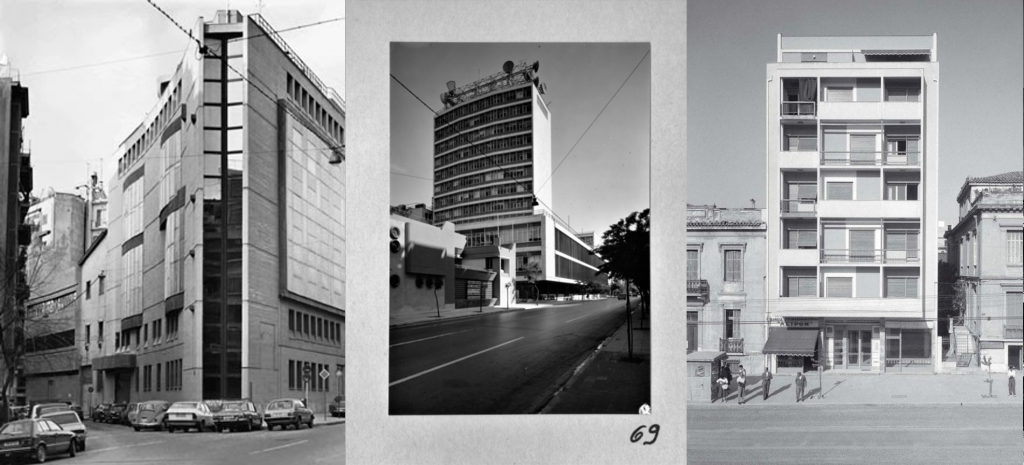Lunch tours (Thursday, June 20 and Friday, June 21, 13.00-15.00):
*on-site registration only
a. interwar masterpieces
The tour focuses on the modern architecture of the 1930s in Athens. The route through the Exarcheia neighborhood includes four stops at four iconic buildings from this period. The buildings, in the order we will encounter them, are the following: the apartment building at Stournari and Zaimi by Polyvios Michailidis and Thoukydidis Valantis, the elementary school by Nikos Mitsakis at the corner of Soultani and Koletti Streets, the Blue Condominium of Exarcheia by Kyriakoulis Panagiotakos, and the Logothetopoulos apartment building by architect Kyprianos Biris

b. postwar masterpieces
The walking tour includes four small visits to representative buildings of Greek postwar architecture. These consist of two large-scale public buildings that symbolize the broader modernization of the city, a multi-storey apartment building (polykatoikia) typical of the era’s mass-produced polykatoikias, and the idiosyncratic house-atelier of an artist—a pure modern building with an interesting story. During the tour, we will see works by K. Kitsikis, K. Krantonellis, D. Fatouros, and A. Provelengios.

c. the apartment buildings of critical regionalism (15 persons max.)
This series of lunch tours includes two building visits, led by Stelios Giamarelos (max. capacity: 15 people):
Thursday: Apartment building on 32 Doxapatri Street by Suzana Antonakaki (1978-1982) / Friday: Apartment building on 118 Benaki Street by Suzana and Dimitris Antonakakis (1972-1974)
Both buildings were designed and built in the 1970s, and were soon regarded as flagship Projects of Critical Regionalism in the early 1980s. Dimitris Antonakakis will join us for the Friday tour.

Post conference tours (Sunday, June 23, 09.00-18.00):
All tours cut through Greece’s strongly multi-layered history, including as much as possible exemplary monuments of antiquity, the byzantine, ottoman and modern periods.
* online registration closed / on-site registration only depending on availability
** complimentary lunch will be offered in all Sunday tours.
a. Aegina Island (by boat and bus)

This tour around the island of Aegina, includes important monuments of antiquity, vernacular and 19th century civic architecture. The 500 BC Doric Temple of Aphaia is the most important monument on the island, a favorite of European travellers of the late 18th and 19th centuries. Large part of its impressively sculpted pediments is exhibited today at the Munich Glyptothek.
Rodakis’s house, an example of vernacular architecture elevated by its owner’ personal genius and labour, acquired mythical importance for a series of 20th century architects, including Pikionis and Kandylis. The newly restored house exemplifies the symbolic weight and heroic, cathartic mission with which vernacurlar architecture was invested by the pioneers of modern architecture.
Aegina served as the newly founded Greek state’s temporary capital, between 1827-1829. A series of neoclassical buildings constructed during the period that Ioannis Kapodistrias governed, testify to the making of a new state, one that claimed both antiquity and Western identity as core elements of its identity.
b. Hosios Loukas – Delphi – Aspra Spitia (by bus)

The tour includes one the most important Byzantine monuments in Greece, the monastery of Hosios Loukas, a complex which comprises of two churches (a 10th century church dedicated to Virgin Mary and an 11th century church dedicated to Hosios Loukas). Since 1990 the monument is a UNESCO World Heritage site.
At Delphi, another UNESCO World Heritage site, lies the pan-hellenic sanctuary of Apollo, a space which at its peak had great religious and political influence over the whole ancient Greek world.
Moving to the post-war era, the tour will conclude at Aspra Spitia (literally, ‘White Houses’), a settlement designed by Greek urban planner Constantinos A. Doxiadis in the 1960s for the workers of ‘Aluminium of Greece S.A.’. Two later expansions were supervised by architects M. Fotiadis, Ch. Lembesis and P. Massouridis.
c. Mycenae – Epidaurus – Nafplio (non available)

The most famous site of mycenaean civilization (1600-1100 BC) and a UNESCO World Heritage Site, Mycenae features the Lions Gate, the Treasury of Atreus and other important monuments that captured the imagination of the ancient and modern world. Strongly connected to the Homeric epics, this archaeological site was excavated at an early stage among others by the controversial Heinrich Schliemann, who was obsessed with Homer.
In Epidaurus (UNESCO World Heritage site) the tour will include the Sanctuary of Asclepius (6th-1st century BC) and the ancient theatre (4th century BC).
Nafplio served as the seat of the provisional government of Greece during the war of independence and later the first official capital from 1829-1834. It is a heavily layered town, with fortifications and monuments dating from the Byzantine, Frankish, Venetian and Ottoman periods. The tour will comment on selected 19th century neoclassical buildings, as well as include Nafplio’s famous modernist XENIA hotel, inside the Akronauplia castle, designed in 1958 by Ioannis Triantafyllidis.
d. Sounio – Lavrio – Athens Riviera (non available)

The Temple of Poseidon, together with the Parthenon and the Temple of Aphaia (see Aegina tour), are the most exemplary monuments of of classical Greek architecture in the region. On the way there, the tour will comment on the Athens Riviera and its post-war development. The tour will end in Lavrion, an area of mining in antiquity and the modern era. Its important industrial heritage is well demonstrated at the Lavrion Technological and Cultural Park, founded in 1992 at the facility of the old French Mining Company of Lavrion (Compagnie Française des Mines du Laurium).
e. Acropolis – Ancient Agora – Philopappos Hill – ‘Asyrmatos’ mass housing (walking tour)

The tour will start from the Acropolis of Athens and then descend to the Ancient Agora. It will then proceed up Philopappos Hill, along the route designed by Dimitris Pikionis, and stop at the Philopappos monument (2nd century CE). It will end at the neighbourhood of Petralona, to discuss two post-war mass housing projects which addressed 1922 refugees and internal migrants still living in slums on the hill.
f. Classicisms and Archaeologies – Athens historical centre (walking tour)

Our current understanding of the ancient monuments of Athens is largely conditioned by their ‘discovery’ by Western antiquarians in the 18th century, and by their institutionalisation after 1830 in the context Greek state-led archaeology. These monuments, however, had been used in many different ways, and assigned different meanings by local populations over the years: fragments of classical temples were incorporated in byzantine churches or vernacular houses, either as simple building materials or as means of magical protection. Ancient ruins were places of worship and philosophical contemplation for local Christians and Muslims alike.
This tour will visit a series of locations in the centre of Athens that demonstrate different uses –symbolic and material appropriations– of the city’s classical past: from the Neoclassical Trilogy of Theophil Hansen and the spolia-filled Byzantine church of Gorgoepikoos, to the vernacular settlement of Anafiotika under the Acropolis.
